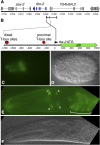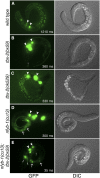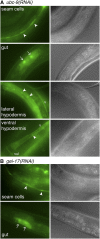Caenorhabditis elegans TBX-2 Directly Regulates Its Own Expression in a Negative Autoregulatory Loop
- PMID: 25873636
- PMCID: PMC4478547
- DOI: 10.1534/g3.115.018101
Caenorhabditis elegans TBX-2 Directly Regulates Its Own Expression in a Negative Autoregulatory Loop
Abstract
T-box genes often exhibit dynamic expression patterns, and their expression levels can be crucial for normal function. Despite the importance of these genes, there is little known about T-box gene regulation. We have focused on the Caenorhabditis elegans gene tbx-2 to understand how T-box gene expression is regulated, and here we demonstrate TBX-2 itself directly represses its own expression in a negative autoregulatory loop. tbx-2 is essential for normal pharyngeal muscle development, and a tbx-2 promoter gfp fusion (Ptbx-2::gfp) is transiently expressed in the pharynx during embryogenesis and in a small number of head neurons in larvae and adults. Reduced tbx-2 function resulted in ectopic Ptbx-2::gfp expression in the seam cells and gut in larvae and adults. Mutation of potential T-box binding sites within the tbx-2 promoter resulted in a similar pattern of ectopic Ptbx-2::gfp expression, and chromatin immunoprecipitation analyses show TBX-2 binds these sites in vivo. This pattern of ectopic Ptbx-2::gfp expression in tbx-2 mutants was very similar to that observed in mutants affecting the NF-Y complex, and our results comparing tbx-2 and nfyb-1 single- and double mutants suggest TBX-2 and NF-Y function in a single pathway to repress the tbx-2 promoter. The tbx-2 promoter is the first direct target identified for TBX-2, and we used it to ask whether SUMOylation is essential for TBX-2 repression. RNAi knockdown of SUMOylation pathway components led to ectopic Ptbx-2::gfp expression in the seam cells and gut. Ectopic Ptbx-2::gfp also was observed in the syncytial hypodermis, suggesting either the tbx-2 promoter is repressed by other SUMOylation dependent mechanisms, or that decreased SUMOylation leads to stable changes in seam cell nuclei as they fuse with the syncytial hypodermis. We suggest negative autoregulation is an important mechanism that allows precise control of tbx-2 expression levels and may allow rapid changes in gene expression during development.
Keywords: C. elegans; NF-Y; SUMOylation; T-box; negative autoregulation.
Copyright © 2015 Milton and Okkema.
Figures






References
-
- Abrahams A., Parker M. I., Prince S., 2010. The T-box transcription factor Tbx2: its role in development and possible implication in cancer. IUBMB Life 62: 92–102. - PubMed
-
- Alon U., 2007. Network motifs: theory and experimental approaches. Nat. Rev. Genet. 8: 450–461. - PubMed
-
- Altun, Z. F., and D. H. Hall, 2009a Epithelial system, hypodermis, in WormAtlas. 10.3908/wormatlas.1.13. Available at http://www.wormatlas.org/hermaphrodite/hypodermis/mainframe.htm. Accessed: April 20, 2015.
-
- Altun, Z. F., and D. H. Hall, 2009b Epithelial system, seam cells, in WormAtlas. 10.3908/wormatlas.1.14. Available at http://www.wormatlas.org/hermaphrodite/seam%20cells/mainframe.htm. Accessed: April 20, 2015.
Publication types
MeSH terms
Substances
Grants and funding
LinkOut - more resources
Full Text Sources
Other Literature Sources
